- Farmers should prepare in advance to ensure chili fences provide the biggest bang for the buck
- Farmers must lead and participate in installing, using, and maintaining any method
- Combine various techniques and be open to new ideas, because no one method is foolproof
The raiding of crops and grain stores by elephants can devastate subsistence farmers, who may retaliate by spearing, snaring, or poisoning elephants. Such conflict between elephants and people is widespread across the range of both African (Parker et al. 2007) and Asian elephants (e.g. Fernando et al 2008).
Reducing elephant crop raiding is a high priority for farmers and wildlife managers, especially as more and more of the land surrounding protected areas and in wildlife corridors is settled and farmed. Numerous technologies have been proposed to keep elephants and other animals out of crops, yet none has found 100% success.
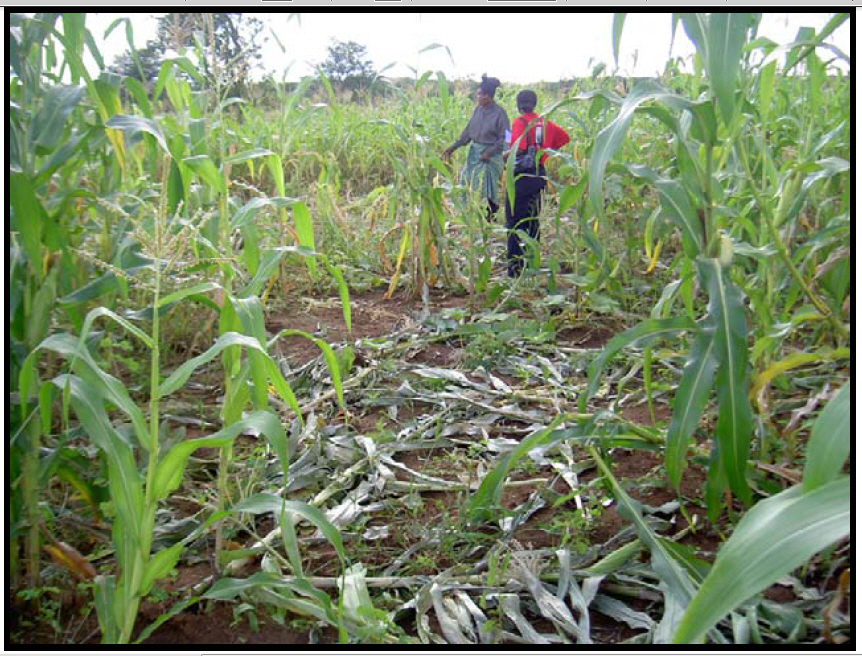
As part of our research on technologies to reduce human-wildlife conflict (HWC), Wildtech is speaking with several experts in the use of chili powder, especially when applied as fencing, to dissuade elephants from entering food crop areas. Elephants have sensitive noses and are repelled by the smell of chili. Fences surrounding crops that are saturated with chili powder, generally mixed with waste engine oil, can be a strong deterrent to marauding elephants, particularly when constructed and managed strategically. We asked these leaders in chili fence “technology”, to list 5-10 top ways to make chili fences more effective.
Here in the first of a series of reports, we report on the top suggestions of Loki Osborn, one of the pioneers in designing and deploying chili fences.
- Plan for deployment before crops are ripening.
The problem, says Osborn, is that elephants will more readily approach fields that they have entered previously: “…often the big male in a bachelor group will come and start poking around looking for interesting opportunities. So before the whole [ripening] season starts, we get the farmers to reorganize how their field is sitting. The idea is that you don’t want to let a single elephant get into your field from day one—you can’t go in the middle of the crop raiding season and stick that string fence up and put some chili on it and expect to stop elephants, it just won’t work.”
A lot of farmers say well we’d like to go home and not have to stay out, but if you’re going to plant fields 2 or 3 km from where you live, which is often what happens, you can’t expect to put a field in the middle of elephant country with all the other animals and leave it with nobody there and go home without any defense.”
- Involve the community, physically and financially and convince farmers to work together.
Osborn stressed the importance of achieving community ownership: “I think the concept of community-based conflict mitigation, whether it’s chilies or not, is fundamentally sound. It cannot be dependent on outsiders. You can’t come in and pay people to set up this idea…it has to be something that grows organically with the people.
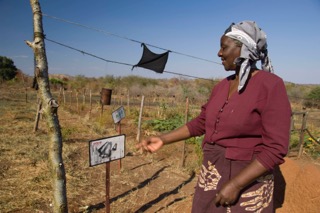
Farmers would say ‘well you know it’s not our elephants, go shoot them’. Suggesting to communities that ‘if you plant the stuff and you’re interested in trying to harvest this season, it’s your job to keep the animals out! We don’t care whether you do or not,’ was amazingly effective.”
“You might participate yourself”, he continued, “and actually getting out there and doing it with them is quite a powerful message that you’re willing to get dirty with them and set it up. Within a few hours, you can actually encircle a village with a simple fence and get all of these things going. But if you pay somebody to do it, it suddenly turns into an electric fence, [and farmers say], ’well it’s not my fence and you paid somebody to do it’, so we never talk about money.”
Osborn explained, “We do work with the farmers to be able to work together. So you start a sense that if an elephant gets into one field—every farmer needs to help that farmer chase that animal away, cause you’re just as likely to get it in your field at some point. You create this gang of guys who are the elephant chasers and they get a bit of, you know, a buzz in their community.”
“I think those things are often missed, even though we try to say all of that in our material, somebody will come in and pay somebody to put in a fence and they’ll decide the fence line [rather than farmers deciding]. The other way is you get each individual farmer to decide where the fence goes— and it can be moved any day, so you can take it out and move it any time that you want, [in case] it’s not in the right place…”
- Educate elephants by priming them for a bad experience and make them afraid of human settlements.
Osborn emphasized that a chili fence will be far more effective if the area’s potential raiders already dislike the unpleasant scent and feel of chili powder. “The logic was that you can educate elephants by giving them a very powerful, negative experience. So we are trying to associate places with bad experiences, as their reaction has always been retreat because it is a bit like somebody throwing sand in your face. You can’t fight if you can’t see, and elephants don’t see very well—everything they get from their world is from their nose.”
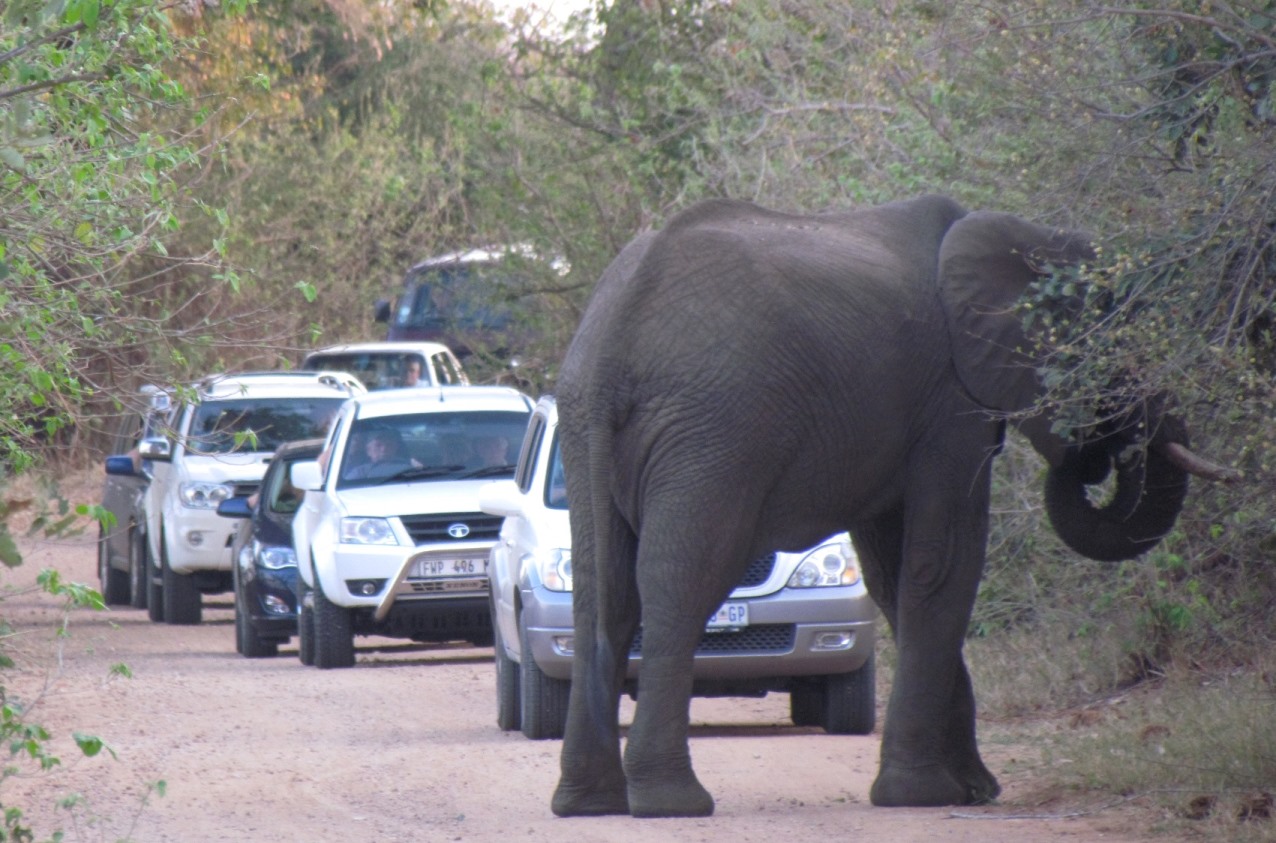
So his colleague, Mike La Grange developed a ‘hi-tech’ approach to complement the low-tech methods, including shooting them with a type of ping-pong ball that contains concentrated oleo (chili) resin that they launch at an elephant’s shoulder to give it a bad experience with chili.
Osborn explained about La Grange’s system, “Basically he makes a high-grade liquid using hexane and a kilogram of chili and you can make an ounce. Dry chili is usually about 25-30,000 scoville units [heat index]—we make oil that’s about 150,000. We put that into a very simple PVC pipe…it’s a really simple design. Put a little bit of lighter fluid into a container and then use a taser as an ignition source, and it fires these balls level and flat and accurately for about 60-70 meters.
You can approach an elephant and then just machine gun the area in front of them or on them or around them, give them a horrendous experience…it breaks open when it hits them or the ground or you shoot trees next to them. You really need to only get a tiny little bit to them for the reaction.”
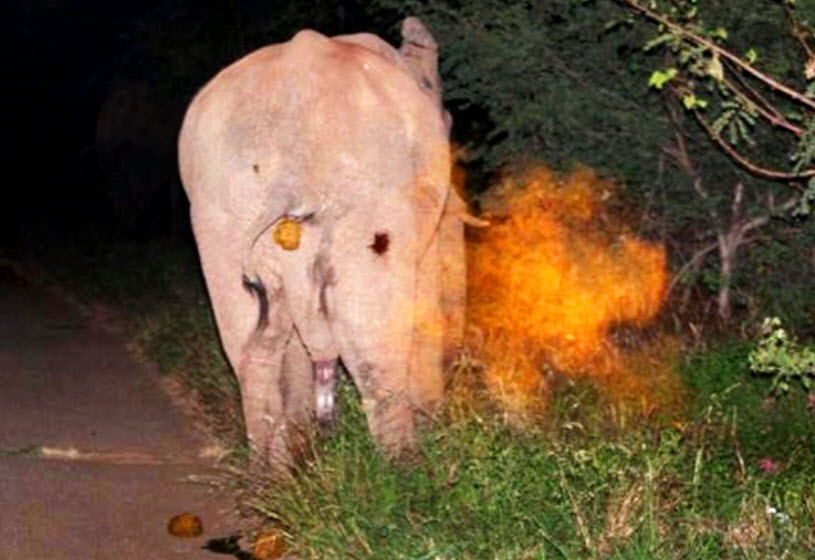
“With regards to the simple chili oil fences, we’ve found that they can’t cross it without getting grease and or chili on their system– they’ll touch it with their trunk, and then suddenly they react dramatically and the other elephant will come and stick their trunk in the other’s mouth and they’ll get it. You can just see the look of ‘What has happened here?,’ and they will then try to find another way around the fence.”
“The idea is a few nights of harassing elephants with the ‘active methods’ reinforces the negative impact and when the elephants suddenly come upon burning chili or a chili fence, they are much more nervous and much more respectful of it. It’s a very hard thing to test whether that is necessary, we could probably do something far less…”
- Integrate several low-tech solutions concurrently.
Complementing chili fences with other low-tech tactics at increasing distances from crops adds to their success. For example, some farmers create bricks made out of cow dung mixed with chili and water and burn them at the edges of fields. Osborn explained that smoke from these bricks emanates into surrounding grass, which elephants will pick up as they move toward the fields – “elephants are incredibly receptive to smell and can pick up parts per trillion of pheromones,” he said, “so you can have even a tiny bit of smoke with chili in it, over a couple of kilometers away, they start vocalizing. As they come closer to the fence, the intensity increases.”
Osborn further encouraged setting buffer zones, areas roughly 5 meters on either side of a fence in which farmers clear away all of the secondary growth. “You don’t want the elephants to leave a thick forest and be able to walk straight into a field of maze– you want it open– elephants hate walking through an open space, even at night.”
“Mixing alarm systems — bells or tin cans on the chili fence – also helps reinforce the negative experience,” said Osborn. “[At night], the farmers are still sleeping in their huts and they don’t want to wake up with an elephant right next to them. So they’ve got this alarm system, even if [the elephants] get into the fence and they start to move through, they can’t do it silently– so they can’t come in stealthily, and that’s their strategy. Especially with a population of elephants that hasn’t experienced it before, if you start those things together before the crops [ripen – see suggestion #1], we were just amazed at how effective that was.”
In other words, explained Osborn, successful HEC mitigation “is often like layers of an onion: you’ve got an outer layer and then you’ve got the various [deterrence actions]…none of the systems are things that farmers can just [deploy and] go to sleep, they’ve got to still be in the field and take responsibility for their own crops. None of these things are making it foolproof.”
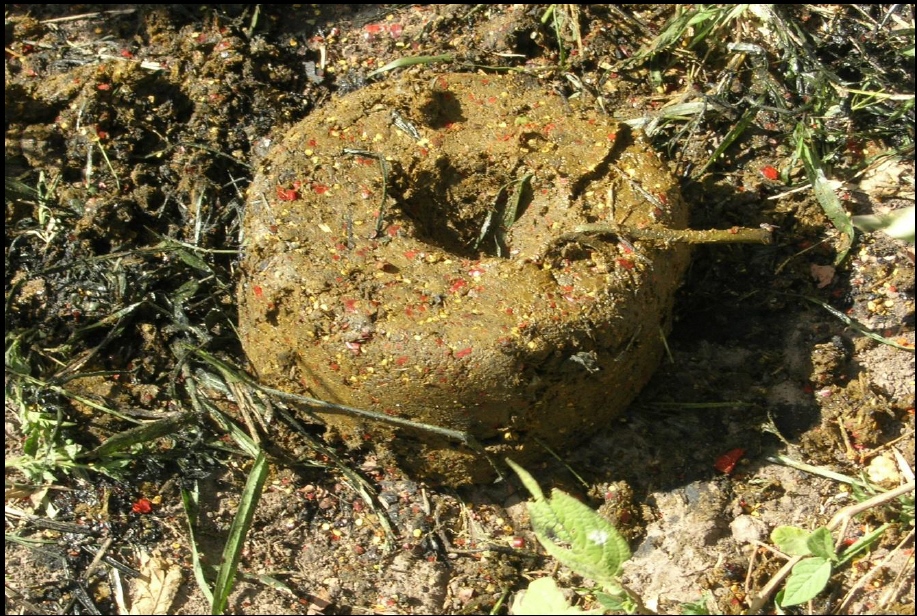
- Follow all steps.
A big problem, suggested Osborn, is that many new users have tried to cut corners rather than use the full complement of procedures. “What do you think,” he lamented, “you put a piece of string in the bush and put a little chili on it and then walk away? Of course that’s not going to work.”
And elephants are persistent: research has found that the reaction of young bulls to having one of their bachelor herd killed was “basically non-existent—they would run away, three nights later they’d be back raiding crops in the field next to where their brother was shot.”
Osborn helped produce a community-based HEC mitigation manual – “a sort of 4-day workshop that we encourage people to download. If you go through the workshop, it shows all of the different steps and it spends time with the community talking about how to- thinking about conflict, not just in their situation but in other places- what are the drivers of conflict and on. Also role playing and bringing different conflict situations and talking about the options that are there.” He said that he and his team “tried to get as many manuals out as we could and trumpet this story, but the reaction was interesting. People would pick up one aspect of it, they’d test it for a little while and just go ‘this is rubbish’, but they didn’t give it a fair shot.”

- Intensify agriculture and minimize area needing protection using natural fertilizer and better seeds.
Osborn made the point that while farmers often complain about wildlife because the elephants destroy the immature plants, “it doesn’t necessarily mean that the plants would have matured into anything useful anyway”. Sometimes poor yields are due not to crop raiding but to poor soils and seeds.
“You want to intensify your agriculture: instead of trying to expand – you put all of your energy into intensifying your own agriculture, you’re going to produce more and you can protect it better,” he said.
Make sure you have good seeds: “What we’ve found is that…a lot of times farmers are using second-generation hybrid seed that they’ve been given by the government [that] just doesn’t work. So we started working with open-pollinated varieties of maize, so they didn’t have to go back to the seed company. One of our measures was how much people were harvesting, but what we found [in those cases] was that if we stop all the elephants, people still wouldn’t harvest anything.”
Enrich with natural fertilizers: Farmers can allow livestock to wander and defecate (fertilize) fields or apply compost, ash, or termite mounds, which, he says, “is brilliant because often it is bringing out micronutrients from lower soil levels. If you keep it in the same field, and intensify every year, you build up [nutrients]…a lot of these soils, especially here [in the Kalahari and other arid regions of southern Africa], it is all sands, there’s no structure to it, and I think Africa’s got very, in general, very poor soil that needs an awful lot of extension to give it structure so it grows better.”
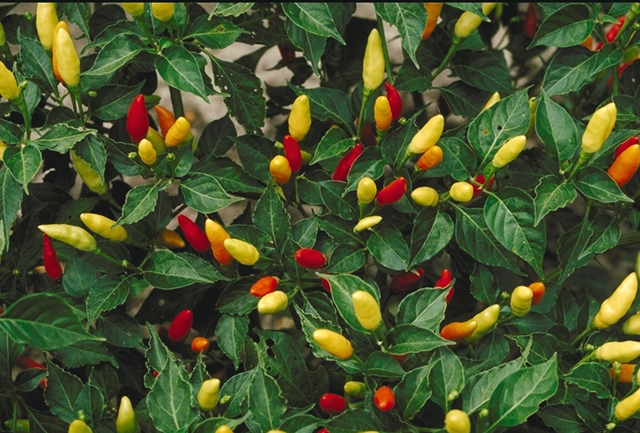
- Commercialize the growing of chili and other cash crops elephants don’t like.
Osborn calls for commercializing the growing of chili and similar unpalatable crops (Parker and Osborn 2006) as one way to encourage the use of chili as a deterrence, since agriculture in southern Africa is challenging. “Most farmers didn’t pick the border of Hwange National Park, for example, or around the Chobe Enclave in Botswana as a place to cultivate,” said Osborn., “But the famers have to make a living, and we are working hard to also find appropriate crops for people to grow…and we started encouraging people to grow chili or other unpalatable crops and we started a business buying back different conflict-reducing crops as opposed to cereals. We grow commercially with people living all over southern Africa. Our particular interest is doing it in areas of high conflict, so we grow ‘wildlife friendly’ crops with people across the five countries that make up the KAZA Trans-Frontier Conservation Area.
And, Osborn pointed out, special varieties are not necessary. “Some people say ‘our chilies are not strong enough’, but it’s not about the strength of the chili….You just need a little bit of it and basically get it to them strategically.”
He explained that capsaicin– the molecule in chili that makes it [burn], is affected by moisture. “So if you put it on your skin, it doesn’t hurt that much. If you stick it in your eye or up your nose or in your mouth, it does because of mucus membranes. Elephants’ trunks are completely coated with mucus membranes, and they’ve got incredible receptors all the way up to this massive olfactory bulb at the top. As the capsaicin comes in, it binds with all of the mucus up the trunk- so the pain is beyond anything that we can probably feel — they can pick up tiny bits of it in the air.”
So, he continued, “if the elephants know that they will feel this major irritation when they go into these field, they will avoid them.”
“It’s like bears in the United States that get used to raiding campgrounds– they lose their respect for people altogether and they’ll walk right up. So what you want is for elephants to fear coming in to human settlement. You’re doing them a huge favor by doing it, so I think the ethics of it are pretty straightforward.”
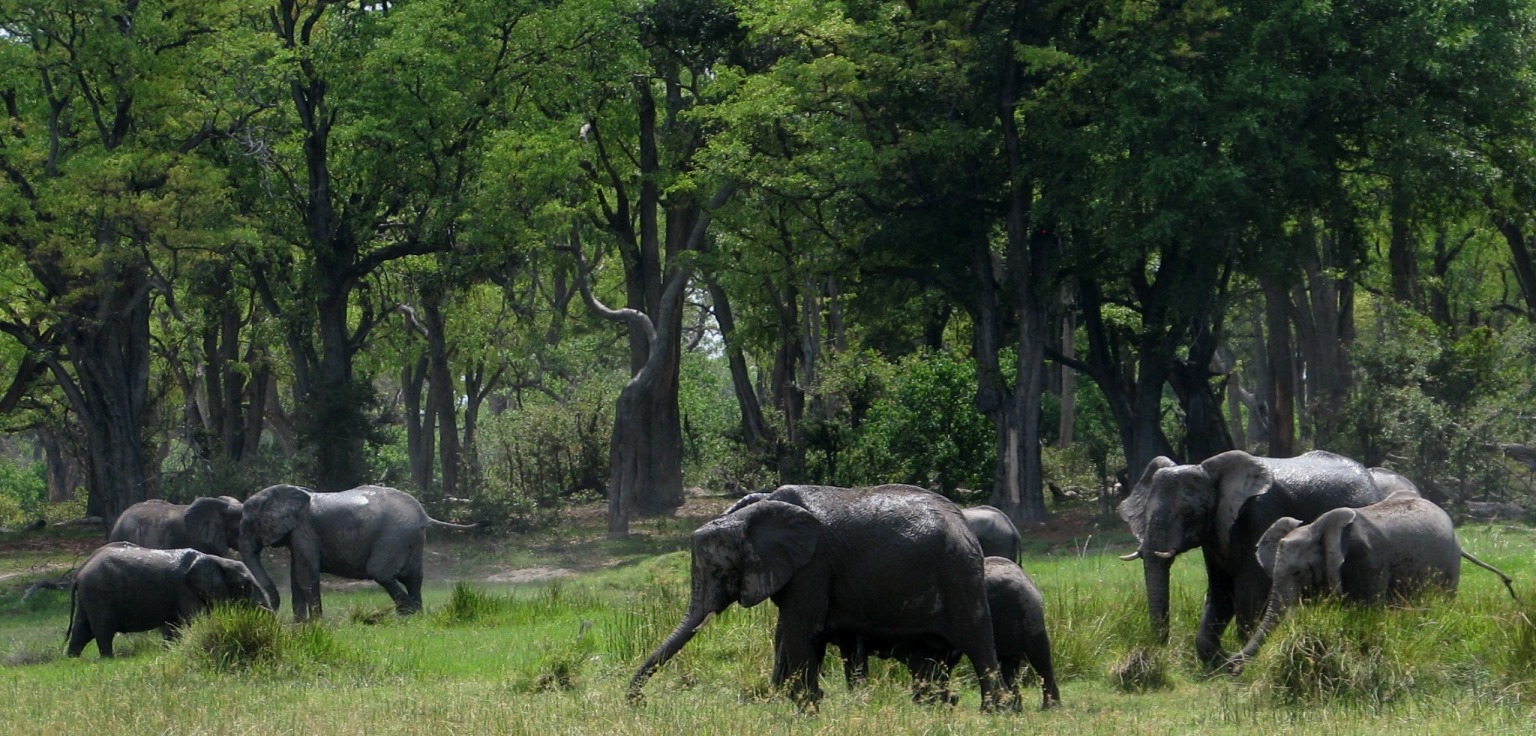
References
Fernando, P., Kumar, M. A., Williams, A. C., Wikramanayake, E., Aziz, T., & Singh, S. M. 2008. Review of human-elephant conflict mitigation measures practiced in South Asia. AREAS technical support document submitted to World Bank. WWF–World Wide Fund for Nature.
Hoare, R. E. 2015. Lessons from 20 years of human–elephant conflict mitigation in Africa. Human Dimensions of Wildlife 20:289-295.
Karidozo M. and Osborn F. V. 2015. Community-based conflict mitigation trials: results of field tests of chilli as an elephant deterrent. Journal of Biodiversity of Endangered Species 3: 144. doi:10.4172/2332-2543.1000144.
Bel S., La Grange M., Drouet N. 2015. Repelling elephants with a chilli pepper gas dispenser: field tests and practical use in Mozambique, Zambia and Zimbabwe from 2009 to 2013. Pachyderm 1.56: 87-96.
Lee, P. C., and Graham, M. D. 2006. African elephants Loxodonta africana and human‐elephant interactions: implications for conservation. International Zoo Yearbook, 40(1), 9-19.
Osborn, F. V. 2002. Capsicum oleoresin as an elephant repellent: field trials in the communal lands of Zimbabwe. Journal of Wildlife Management 66:674–677.
Osborn, F. V. and Parker, G. E. 2002. Community based methods to reduce crop losses to elephants: experiments in the communal lands of Zimbabwe. Pachyderm 33:32–38.
Parker, G. E. and Osborn, F. V. 2006. Investigating the potential for chilli Capiscum annuum to reduce human-wildlife conflict in Zimbabwe. Oryx 40:343-346.
Parker, G. E., Osborn, F. V., Hoare, R. E. and Niskanen, L. E. Eds. 2007. Human elephant conflict mitigation: a training course for community-based approaches in Africa. A trainer’s manual. Nairobi: Elephant Pepper Trust, Livingstone, Zambia and IUCN/SSC AfESG. http://www.african-elephant.org/hec/pdfs/ heccombappmen.pdf.
